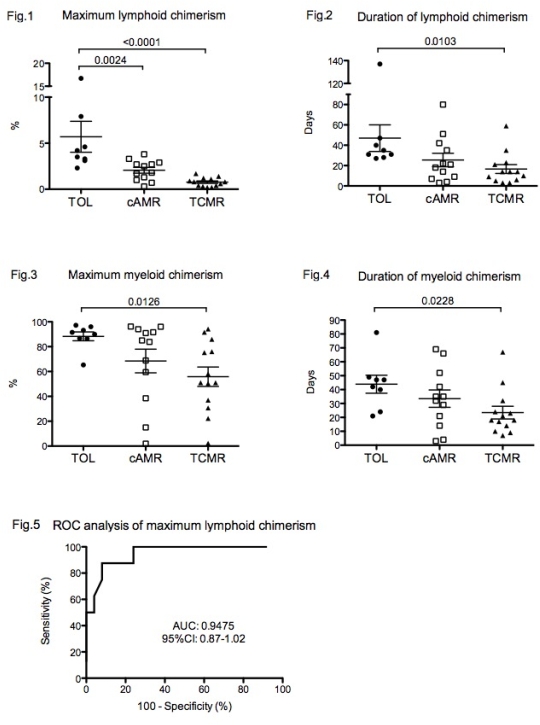Characterization of Renal Allograft Tolerance Induction via Transient Mixed Chimerism in Non-Human Primates
1Surgery, Center for Transplantation Sciences, Massachusetts General Hospital, Boston
2Pathology, Massachusetts General Hospital, Boston.
Meeting: 2018 American Transplant Congress
Abstract number: A401
Keywords: Bone marrow transplantation, Kidney transplantation, Rejection
Session Information
Session Name: Poster Session A: Tolerance / Immune Deviation
Session Type: Poster Session
Date: Saturday, June 2, 2018
Session Time: 5:30pm-7:30pm
 Presentation Time: 5:30pm-7:30pm
Presentation Time: 5:30pm-7:30pm
Location: Hall 4EF
Background: We have previously reported long-term renal allograft tolerance after induction of transient mixed chimerism in non-human primates. However, some recipients developed late onset chronic rejection with donor specific antibody (DSA) and identification of biomarkers that can predict eventual transplant outcomes is critically important to safely withdraw immunosuppression.
Methods: The results of mixed chimerism in 46 recipients, that received conditioning regimen and MHC-mismatched donor bone marrow transplantation (DBMT) simultaneously or 4 months after kidney transplantation, were retrospectively analyzed. The conditioning regimens of DBMT were consisted of low-dose TBI, thymic irradiation and ATG. Following DBMT, co-stimulatory blockades (2 weeks) and CNI (4 weeks). The results were analyzed by receiver operating curve characteristics (ROC).
Results: Among 33 DBMT recipients in which transient chimerism was detected, 8/33 recipients achieved renal allograft tolerance (TOL) (graft survival 1415 ± 472 days), 12/33 developed chronic antibody mediated rejection (cAMR) with DSA (846 ± 176 days) and 13/33 developed T-cell mediated rejection (TCMR) (86 ± 8 days). The remaining 13 recipients which failed to develop chimerism resulted in TCMR. The maximum level of lymphoid chimerism was significantly higher in TOL vs. cAMR or vs. TCMR (Fig. 1) and duration of chimerism significantly longer in TOL vs. TCMR (Fig. 2). The maximum levels and duration of myeloid chimerism were significantly higher in TOL vs. TCMR. (Fig. 3, 4) ROC analysis (Fig. 5) showed that the maximum level of lymphoid chimerism reliably predict transplant outcome with AUC 0.94 and 95%CI 0.87-1.02.
Conclusion: The maximum level of lymphoid chimerism is the most reliable biomarker that was associated with the transplant outcome.
CITATION INFORMATION: Sasaki H., Thaiss C., Oura T., Rosales A., Smith R., Colvin R., Cosimi B., Kawai T. Characterization of Renal Allograft Tolerance Induction via Transient Mixed Chimerism in Non-Human Primates Am J Transplant. 2017;17 (suppl 3).
To cite this abstract in AMA style:
Sasaki H, Thaiss C, Oura T, Rosales A, Smith R, Colvin R, Cosimi B, Kawai T. Characterization of Renal Allograft Tolerance Induction via Transient Mixed Chimerism in Non-Human Primates [abstract]. https://atcmeetingabstracts.com/abstract/characterization-of-renal-allograft-tolerance-induction-via-transient-mixed-chimerism-in-non-human-primates/. Accessed December 17, 2025.« Back to 2018 American Transplant Congress
